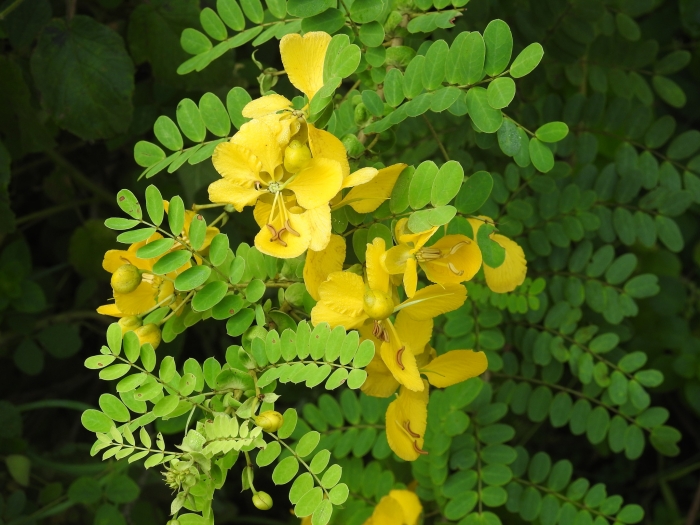Avaram
(Senna auriculata)
Avaram (Senna auriculata)
/
/

Raja bandi
CC BY 4.0
Image By:
Raja bandi
Recorded By:
Copyright:
CC BY 4.0
Copyright Notice:
Photo by: Raja bandi | License Type: CC BY 4.0 | License URL: http://creativecommons.org/licenses/by/4.0/ | Rights Holder: Raja bandi | Publisher: iNaturalist | Date Created: 2020-10-21T08:22:26-07:00 |

























Estimated Native Range
Summary
Senna auriculata, commonly known as avaram or matura tea tree, is a deciduous shrub native to the dry deciduous forests and coastal scrublands of India and Sri Lanka. It typically grows to a height of 1.5 to 3 meters and spreads 1 to 2 meters wide. The plant has a rounded form with pinnate leaves that are green in color. It produces bright yellow flowers in dense racemes, which are highly showy and bloom throughout the year, with a peak flowering season from July to November. The bark is smooth and cinnamon-brown, and the plant may produce flat, brown seed pods.
Avaram is valued for its bright, cheerful flowers and its ability to thrive in poor, arid soils, making it a popular choice for drought-tolerant landscapes and reforestation projects. It is used in traditional medicine, particularly in Ayurveda, for treating diabetes, skin conditions, and as a detoxifying agent. In cultivation, avaram prefers full sun and can tolerate a range of soil types, provided they are well-drained. It is relatively low-maintenance, requiring minimal water once established. This shrub is also used for its tannins in dyeing and for its wood in carpentry. However, gardeners should be aware that it can spread through seed, potentially becoming weedy in favorable conditions.CC BY-SA 4.0
Avaram is valued for its bright, cheerful flowers and its ability to thrive in poor, arid soils, making it a popular choice for drought-tolerant landscapes and reforestation projects. It is used in traditional medicine, particularly in Ayurveda, for treating diabetes, skin conditions, and as a detoxifying agent. In cultivation, avaram prefers full sun and can tolerate a range of soil types, provided they are well-drained. It is relatively low-maintenance, requiring minimal water once established. This shrub is also used for its tannins in dyeing and for its wood in carpentry. However, gardeners should be aware that it can spread through seed, potentially becoming weedy in favorable conditions.CC BY-SA 4.0
Plant Description
- Plant Type: Tree, Shrub
- Height: 5-10 feet
- Width: 3-5 feet
- Growth Rate: Moderate
- Flower Color: Yellow
- Flowering Season: Summer, Fall
- Leaf Retention: Deciduous
Growth Requirements
- Sun: Full Sun
- Water: Medium
- Drainage: Medium, Fast
Common Uses
Bird Garden, Butterfly Garden, Low Maintenance, Showy Flowers, Street Planting
Natural Habitat
Dry deciduous forests and coastal scrublands
Other Names
Common Names: Tanners Cassia, Ranawara, Avarum, Avaram Senna
Scientific Names: , Senna auriculata, Cassia auriculata, Cassia densistipulata,
GBIF Accepted Name: